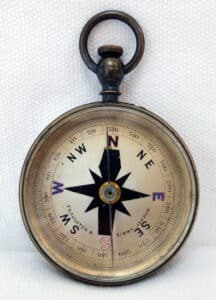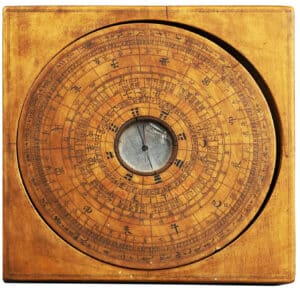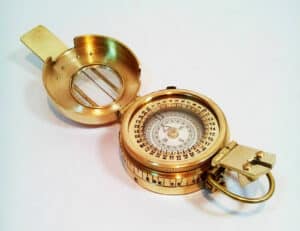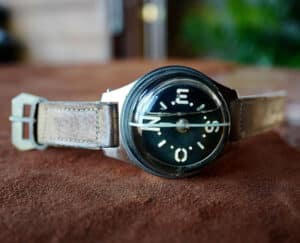by Jessica Kosinski

Do you need a little direction in your life? Well, if you are ever lost in the woods, an ancient device will have you covered! Compasses are well-known navigation tools. In today’s era of modern technology, people tend to use cellular phones to find their way. However, many true outdoor enthusiasts still want “real” compasses for practical purposes, especially when they are in areas where the phone signals are spotty. Many people collect compasses because they are such interesting instruments. Let’s take a peek at the long, rich history of compass development and use.
What is a Compass?
A compass is a navigation tool that displays the direction of travel for the user relative to magnetic north. Because the Earth’s poles are magnetic, compasses typically use magnetized needles. The compass was designed to point to magnetic north located near Earth’s North Pole. Once magnetic north is identified, the user can easily determine which way is east, south, or west. Modern compasses are vital navigation tools for travelers, hikers, and campers. They are also used in various industries, such as boating and airline travel.
Non-Navigation Uses for Early Chinese Compasses

Although widely known today for their navigational uses, compasses were not always used solely for navigation. They are believed to have originated in China between 300 and 200 BC, which was in the Han Dynasty era. At that time, compasses were thought to be magical primarily due to their constant ability to move seemingly on their own to point north.
Early compasses were also household tools in China. They were used to assist with the ancient art of feng shui. Feng shui is the practice of trying to stay naturally balanced within a home or other space by arranging furniture and other items in a specific way. Compasses helped practitioners make sure certain furniture pieces faced specific directions.
Wet Versus Dry Compasses
Another important advancement in the development of compasses also came from China around the 7th century. At that time, compasses that could float on the water were invented. Magnetized compasses suspended from strings were also popular. The wet and dry compasses made navigation possible in almost any environment or situation, yet continued to each have advantages and disadvantages for centuries until Tuomas Vohlonen of Finland invented the portable liquid-filled compass that was reliable. Up until that point, all other liquid compasses tended to leak or have other problems, while dry compasses were too easily thrown off by any slight movement.
Compasses Outside of China
Since the magnetic stone used to make early compasses originated in China, it may come as no surprise that China seemingly had a monopoly on those early compasses. Some were used outside the country, especially by mariners. However, they did not start to become popularized across Europe until the 1300s. European sailors relied upon star navigation until that point. Eventually, the use of compasses for water navigation became common worldwide. Since then, the compass has likewise helped people in many different fields and endeavors, ranging from aviation to land surveying.
Magnetic North Versus True North

There are two terms used in compass navigation that can be confusing to those who do not use compasses regularly: “magnetic north” and “true north.” True north is the direction in which the North Pole is located – a specific point on the planet. Magnetic north changes a bit based on environmental factors and other issues. Think of it more like “north-ish.”
A huge change in how compasses were made came about in Europe in the 1400s when people began to realize true north and magnetic north were different. At that point, meridional compasses were born. They were British compasses that were essentially calibrated to point north when ships passed a particular area of the city of Cornwall.
Compass Dial Changes
If you want to collect early compasses, you need to familiarize yourself with certain dial changes. For example, the earliest European compasses only had south and north marked on them. Eventually, the compass “rose” was developed. The compass rose had 32 directional points on it. They were used for directional tracking, but they also assisted with weather tracking. In fact, they typically depicted various winds.
Another change that developed over time was the affixing of the compass needle to a pin. This allowed the needle to spin freely around atop the pin.
Collecting Compasses

Compasses have existed since ancient times, and they are still made today. As a collector, that leaves you with a vast array of options. You can focus on an era, type (dry, wet, etc.), or country of manufacture, for example. You may also opt to collect unusual compasses that tickle your fancy. For example, some compasses included sundials, some had intricate carry cases, and others were attached to chains like pocket watches. They were also built from a variety of materials, colors, and sizes. Some even feature unique decorations, such as sea creatures.
It is up to you to locate compasses that catch your eye. You may even want to extend your collection to items depicting compass markings, such as maps and other navigation tools.





Related posts: